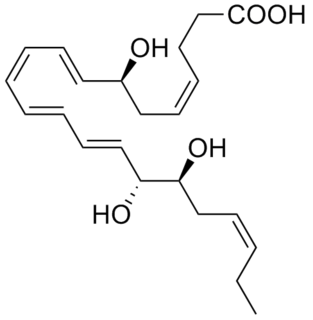This page is based on this
Wikipedia article Text is available under the
CC BY-SA 4.0 license; additional terms may apply.
Images, videos and audio are available under their respective licenses.
The quinones are a class of organic compounds that are formally "derived from aromatic compounds [such as benzene or naphthalene] by conversion of an even number of –CH= groups into –C(=O)– groups with any necessary rearrangement of double bonds", resulting in "a fully conjugated cyclic dione structure". The class includes some heterocyclic compounds.

Resolvins are metabolic byproducts of omega-3 fatty acids, primarily eicosapentaenoic acid (EPA) and docosahexaenoic acid (DHA), as well as docosapentaenoic acid (DPA) and clupanodonic acid. As autacoids similar to hormones acting on local tissues, resolvins are under preliminary research for their involvement in promoting restoration of normal cellular function following the inflammation that occurs after tissue injury. Resolvins belong to a class of polyunsaturated fatty acid (PUFA) metabolites termed specialized proresolving mediators (SPMs).

1,4-Benzoquinone, commonly known as para-quinone, is a chemical compound with the formula C6H4O2. In a pure state, it forms bright-yellow crystals with a characteristic irritating odor, resembling that of chlorine, bleach, and hot plastic or formaldehyde. This six-membered ring compound is the oxidized derivative of 1,4-hydroquinone. The molecule is multifunctional: it exhibits properties of a ketone, forming an oxime; an oxidant, forming the dihydroxy derivative; and an alkene, undergoing addition reactions, especially those typical for α,β-unsaturated ketones. 1,4-Benzoquinone is sensitive toward both strong mineral acids and alkali, which cause condensation and decomposition of the compound.
1,2-Benzoquinone, also called ortho-benzoquinone, is an organic compound with formula C6H4O2. It is one of the two isomers of quinone, the other being 1,4-benzoquinone. It is a red volatile solid that is soluble in water and ethyl ether. It is rarely encountered because of its instability, but it is of fundamental interest as the parent ortho-quinone, of which many analogues are known.
In enzymology, a 3-dehydro-L-gulonate 2-dehydrogenase (EC 1.1.1.130) is an enzyme that catalyzes the chemical reaction:
Epi-lipoxins are trihydroxy metabolites of arachidonic acid. They are 15R-epimers of their lipoxin counterparts; that is, the epi-lipoxins, 15-epi-lipoxin A4 (15-epi-LxA4) and 15-epi-lipoxin B4 (15-epi-LXB4), differ from their respective lipoxin A4 (LxA4) and lipoxin B4 (LxB4) epimers in that their 15-hydroxy residue has R rather than S chirality. Formulae for these lipoxins (Lx) are:
In enzymology, a 3alpha,7alpha,12alpha-trihydroxycholestan-26-al 26-oxidoreductase is an enzyme that catalyzes the chemical reaction:
In enzymology, a 3alpha,7alpha,12alpha-trihydroxy-5beta-cholestanoyl-CoA 24-hydroxylase (EC 1.17.99.3) is an enzyme that catalyzes the chemical reaction
In enzymology, a propanoyl-CoA C-acyltransferase is an enzyme that catalyzes the chemical reaction

Tetrahydroxy-1,4-benzoquinone, also called tetrahydroxy-p-benzoquinone, tetrahydroxybenzoquinone, or tetrahydroxyquinone (THBQ, THQ), is an organic compound with formula C6O2(OH)4. Its molecular structure consists of a cyclohexadiene ring with four hydroxyl groups and two ketone groups in opposite (para) positions.

Chloranil is a quinone with the molecular formula C6Cl4O2. Also known as tetrachloro-1,4-benzoquinone, it is a yellow solid. Like the parent benzoquinone, chloranil is a planar molecule that functions as a mild oxidant.

Chloranilic acid is an organic compound with the chemical formula C6H2Cl2O4.

Phyllostachys edulis, moso bamboo, or tortoise-shell bamboo, or mao zhu, is a temperate species of giant timber bamboo native to China and Taiwan and naturalised elsewhere, including Japan where it is widely distributed south of Hokkaido. The edulis part of the Latin name refers to its edible shoots. This bamboo can reach heights of up to 28 m (92 ft). This particular species of bamboo is the most common species used in the bamboo textile industry of China, for the production of rayon.
A hydroxybenzoquinone is any of several organic compounds that can be viewed as derivatives of a benzoquinone through replacement of one hydrogen atom (H) by a hydroxyl group (-OH).
2,5-Dihydroxy-1,4-benzoquinone or 2,5-dihydroxy-para-benzoquinone is an organic compound with formula C
6H
4O
4, formally derived from 1,4-benzoquinone by replacing two hydrogen atoms with hydroxyl (OH) groups. It is one of seven dihydroxybenzoquinone isomers. It is a yellow solid with planar molecules that exhibits ferroelectric properties.

In chemistry, 1,4-benzoquinonetetracarboxylic acid is an organic compound with formula C
10H
4O
10, or (C6O2)(-(CO)OH)4, which can be viewed as deriving from para-benzoquinone C
6H
4O
2 through replacement of the four hydrogen atoms by carboxyl functional groups -(CO)OH.
The molecular formula C6H4O4 may refer to:

2,6-Dimethoxybenzoquinone (2,6-DMBQ) is a benzoquinone, a chemical compound found in Rauvolfia vomitoria and in Tibouchina pulchra.
Cholate—CoA ligase is an enzyme with systematic name cholate:CoA ligase (AMP-forming). This enzyme catalyses the following chemical reaction








